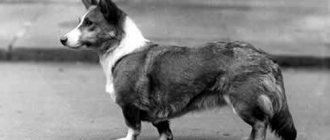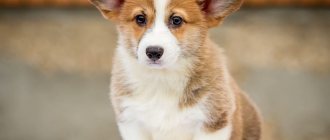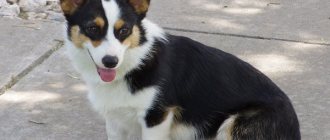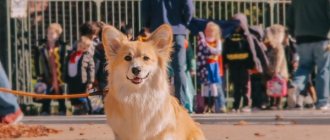| Breed name: | Welsh Corgi Cardigan |
| Breed name in English: | Welsh corgi cardigan |
| Country of origin: | UK (Wales) |
| Type: | A small dog |
| Weight: | 11-17 kilograms |
| Height (height at withers): | 27-33 centimeters |
| Color | White, black, red, grey, blue merle |
| Wool length | Short |
| Lifespan: | 12-15 years |
| Character | Smart, alert, energetic |
| Number of puppies (average): | 3-8 |
| Price of puppies: | From 1000$ |
Appearance
— Advertising —
Height at withers: males 27-33 centimeters, females 27-33 centimeters.
Average weight: men 14-17 kilograms, women 11-15 kilograms.
The size of the breed is small, the body is long and located close to the ground. The animal has a proportional head. The pet's eyes are medium in size, dark brown or blue.
— Advertising —
The dog's ears are large, always erect, with a slight bend forward. The animal's muzzle is short, its nose and lips are black. The jaw has a scissor bite.
The dog's front legs are short, straight, with strong bones. The hind limbs of pets are powerful and muscular.
The breed has a well-proportioned tail that is set low. The tail is carried down when relaxed and may be level with the back when excited.
The animal's fur is medium in size and has a double coating. It is hard to the touch, with a short, soft and dense undercoat. Color can be of different shades and combinations:
- Black, brindle and white.
- Blue and merle (blue merle).
- Brindle and white.
- Red and white.
- Red, brindle and white.
- Ginger.
- Gray and White.
- Tricolor or tricolor.
Typically, dogs have white spots on the neck, chest, face, legs, tip of the tail, and also in the form of a “flame” on the head.
Distinctive features
The Welsh Corgi is built like a herding working sheepdog. Despite their small size, they cope well with herd management due to their agility and reaction speed. At the withers, dogs reach 25-30 cm, weight varies from 9 to 11 kg. Outwardly well built, squat and elongated, females should be slightly smaller than males.
The last breed standard was published in 1987 . All dogs that do not correspond to external characteristics, aggressive or passive, are discarded and are not allowed for further breeding.
- The head is diamond-shaped from the front, shaped like a fox. The skull is flattened on top. Domed is a disqualifying fault. The size matches the body. Stop is expressed moderately.
- The length of the muzzle is in relation to the length of the head as 3:5, not blunt, but rounded. Tapers towards the tip of the nose. Cheekbones are flat. The jaws are strong and strong, with a scissor bite The lips close tightly, are not jagged, and are pigmented black.
- The nose is round and large with well-opened nostrils. The color is either black or butterfly.
- The eyes are round and medium in size. Set wide, some convexity is acceptable. The color of the iris is dark; blue merles can be blue.
- The ears are set on the sides of the head, quite high and wide. They are big and stand strong. They are wide at the base, slightly tapering and rounded towards the tips.
- The body is elongated, strong and strong. The croup is slightly raised and smoothly sloping. The back is straight and long, the loin is short and wide. The chest is well descended (deep). The neck is long and muscular. The withers are pronounced.
- The tail is set below the back line, called “fox”, similar in shape and fur. When excited it rises, but never curls.
- Limbs are short. The front ones are characterized by bringing the elbows closer together. The hindquarters are not so widely spaced, muscular and strong. The paws are large, rounded with wide pads, slightly turned in different directions (the hind paws are erect). The claws are black. The movements are light, smooth, creeping (like a lynx).
- The coat is dense, harsh, and of medium length. It feels silky to the touch. The undercoat is dense and soft. The shortest on the ears, limbs and head, elongated on the belly and tail.
- The color can be different: all shades of sable, red, gray, brindle, black gray or merle. There is no preference for the location of white markings.
Pros and cons of a dog
Characteristics of advantages:
- It is an excellent pet as well as a companion dog.
- Dogs are loyal and loving.
- Dogs are smart and easy to train in the right hands.
- Individuals love human company and feel comfortable in it.
- Their coat does not require much grooming.
- Cardigan puppies are easy to train.
- They are good watchdogs.
Characteristics of minuses:
- The breed loses a lot of hair, especially in spring and autumn.
- They are known to suffer from hereditary health problems. You must be prepared to pay for vet visits and medications.
- Dogs are small in size, but they need a lot of daily exercise.
- Individuals have a high hunting instinct.
- Puppies are relatively expensive.
Education and training
One of the biggest stumbling blocks is training a Corgi. Some owners believe that their pet just needs to be loved, without any training. The latter approach this matter more rationally, always working with the dog.
Let's start with the fact that any breed, regardless of its size, must have a basic obedience. The commands “near”, “to me”, “sit” and “lie down” are mandatory; the pet must carry them out not only on the training ground, but also during everyday obedience.
Don't forget: a cardigan is a shepherd. By the way, the breed is included in the TOP 10 according to the rating of refuseniks. People get a dog as a cute toy and face serious problems if there is no training.
By the way, representatives of this breed are excellent for agility and canine freestyle.
History of the breed
The description of the history should begin with the fact that the Cardigan Welsh Corgi is the oldest of the two corgi breeds.
The dog came to the part of Wales (today known as Cardiganshire) when the Celts moved there in 1200 BC. The origin of the name corgi is attributed to the Celtic word for dog (corgi).
Dogs were used to herd cattle. Because of their size, they could nip the heels of livestock while avoiding being hit by their hooves. This became especially valuable to Welsh farmers.
Today there are two closely related corgis: the Cardigan (long-tailed) and the Pembroke (tailless). They share a common history and were interbred and considered the same breed until 1934. In 1935, the American Kennel Club separated them. The Welsh Cardigan Corgi Association has developed an appearance standard for this animal.
Since the 1930s, fans have emphasized the individuality of each species. The Cardigan Welsh Corgi always has a tail; it is slightly heavier and longer than that of the Pembroke. In addition, the Cardigan's ears are larger and wider, and its coat comes in a variety of colors.
In TV series, movies and cartoons
The Welsh Corgi, thanks to its inexhaustible charm and ability to captivate at first sight, often appears on screens. And, we must give them their due, the tailed actors become favorites of the audience. You can see the Welsh Corgi in:
- films “The Lost Puppy”, “The Reluctant Tourist”, “Bullseye!”, “Don’t Tell Mom About the Nanny’s Death”, “Robinson Crusoe” (1997, with Pierce Brosnan), “Agent Johnny English”, “The King’s Speech!” ", "Queen";
- the series “Jeeves and Wooster” (the signature “singing” of the Welsh Corgi is shown here), “Joy to All Who Sorrow” and “NCIS: Special Branch”;
- cartoon "One Hundred and One Dalmatians 2: Adventures in London"
And in the anime series Cowboy Bebop, the Welsh Corgi is shown as the smartest member of the spaceship - so the intelligence of this dog is even captured in the cinema!
Maintenance and care
These pets are easy to keep and care for.
The Cardigan Welsh Corgi's coat is easy to care for. It is enough to clean it with a comb or comb once a week.
The coat repels dirt and water, so dogs rarely need bathing. But if you still need to carry out such a procedure, prepare warm water and a special shampoo for dogs.
Trim your nails and check your ears weekly. Clean them with a special, safe product if they are dirty.
Start training your puppy from day one, then your Cardigan will quickly learn good manners and house rules. The breed is smart and your pet will want to please you. Soft teaching methods will be the most effective.
Give your pet mental and physical exercise daily. The latter will contribute to the good figure of the dog.
Key points in training
- It is important for Corgis to feel the leader in their owner; their character needs to be broken and bribed with treats, in which case they will do everything to please the person.
- They need constant mental stress, so monotonous execution of commands will not work.
- You need to train a puppy from 3-4 months , but you need to accustom it to its name and its place from the first minutes of its appearance in the house. Physical activity should be sufficient, but not excessive.
- An excellent choice would be agility (obstacle course) for short dogs and freestyle.
Read about how to properly train a dog in the article: “Training a puppy: effective methods from dog handlers, learning commands at home.”
Nutrition
When the puppy reaches adulthood, he should be fed a high-quality special food. The approximate amount you should give your dog daily, depending on activity:
- With a weight of 11 kg - from 139 to 196 g.
- With a weight of 14 kg - from 179 to 229 g.
- With a weight of 15 kg - from 189 to 239 g.
- With a weight of 17 kg - from 209 to 259 g.
Feed your pet twice a day, once in the morning and then in the evening. Food must be of high quality and meet the nutritional needs of the breed. It is also important that dogs are given the right amount of exercise to help them burn off excess calories. Otherwise, they may gain excess weight, which leads to all sorts of health problems. Obesity shortens a pet's life by several years.
Description of the Welsh Corgi Cardigan breed
Popularity 20th among 263 dog breeds
Lifespan:
12-15 years
Height:
males: 27-32 cm, females: 25-30 cm
Country of origin:
Great Britain
Average price:
20-30 thousand rubles
Weight:
males: 14-17 kg, females: 12-15 kg
Latest articles Cat health
Rabies vaccination for cats: choice of vaccine, necessity, schedule 01/22/2022 4 0 0
Selection and adaptation
TOP 20 best cat breeds for families with children 01/22/2022 25 0 0
Breeding
Before breeding, make sure the health of the future mother and father. This mainly concerns the absence of genetic diseases.
Favorable age for mating is 20-24 months. Although it should be noted that the first estrus in females occurs at 7-8 months. Before mating, introduce your pets: take a walk with them or leave them in the room for communication.
The pregnancy of a Welsh Corgi lasts from 2 to 2.5 months. After the first month, the bitch’s nipples swell and her tummy becomes rounded. The girl will constantly ask for food. But you must watch your diet so as not to overfeed the expectant mother.
The bitch gives birth to from 3 to 8 puppies. 2-3 hours after birth, wash the newborns and mother with warm water. The birth should be supervised by a specialist who can help in unforeseen situations.
Photos of the puppies are presented below.
Diet: what and how to feed
The typical Cardi feeds well on super-premium or holistic dry food. But among the owners there are those who like to feed their dogs natural products.
Allowed list:
- turkey, lamb, beef, rabbit;
- duck necks;
- -turkey, rabbit, beef by-products;
- vegetables (zucchini, carrots, pumpkin);
- fruits (apples);
- cottage cheese and kefir (no more than 2.5%);
- chicken and quail eggs;
- boiled round grain rice.
By the way, Monge dry food would be a good choice for your pet. It is not particularly expensive, and the yield is small.
Puppies
Prepare some things for the meeting with your new pet. Here is a sample list of items that will be useful to you:
- A well made playpen for your puppy to play in.
- Toys that your baby can chew on during teething. This happens at 3-6 months.
- Good quality water and food bowls. Ideally, they should be ceramic, not plastic or metal.
- A brush with smooth or soft bristles.
- Toothpaste and brush for the dog.
- Scissors with rounded ends.
- Nail clippers.
- Dog shampoo.
- Collar and leash.
- A special crib for your baby that you can make with your own hands.
- Baby blankets that you put in the crib.
When you receive your Cardigan Welsh Corgi puppies from a breeder, he will give you a feeding schedule and diet for the baby. It is important to adhere to the same regime and diet. You can change your diet, but do it gradually. Make sure that your pets do not have any digestive disorders. If they happen after changing your diet, return to the original option. Also consult your veterinarian.
Puppies need to eat quality food. Feed babies 3-4 times a day. Approximate amount of food, which depends on the body of the animal:
- 2 months – from 173 to 181 g.
- 3 months – from 199 g to 213 g.
- 4 months – from 211 to 229 g.
- 5 months – from 214 to 233 g.
- 6 months – from 214 to 233 g.
- 8 months – from 177 to 211 g.
- 10 months – from 159 to 167 g.
When the puppy is 12 months old, he can be fed like an adult dog.
Health and treatment
A number of diseases that can occur in a Welsh Corgi dog:
| Type of pathology | Signs | Methods of therapy |
| Cataract | Clouding of the lens, gradually leading to vision loss | If the form is complicated, surgery is required |
| Retinal atrophy | As it progresses, blindness develops | Almost impossible to treat |
| Glaucoma | Pain due to increased eye pressure | Drops are used to slow down the process of vision loss |
| Eczema | Weeping lesions that cause severe itching | The veterinarian prescribes a course of antibiotics |
| Degenerative myelopathy | Manifests itself in the inability to move the hind limbs due to damage to the spinal cord | Balanced diet, special exercises |
| Epilepsy | Convulsions during recurrent seizures | Cannot be cured. It is recommended to reduce physical activity |
Dog character
These are smart little dogs, and also very energetic. They are suitable for people who live in rural areas and lead an active outdoor life.
Cardigans have a deep-rooted hunting instinct. Therefore, you need to monitor your pet from childhood and not allow him to chew on everything.
Animals must be socialized from an early age. They may be aloof and a little wary of people they don't know. Dogs rarely show aggression towards strangers, preferring to keep their distance.
They are an ideal choice for first-time dog owners because they are very friendly and people-oriented. Animals love to entertain their families. They get along especially well with children and the elderly.
The breed forms strong bonds with their families. They generally do not suffer from separation anxiety when left alone. But this loneliness should not last long. No dog likes to be left alone for long periods of time. This can lead to various unwanted and destructive actions in the house by the dog.
It should be taken into account that some individuals like to bark constantly, while others only bark when they see strangers. Cardigan Welsh Corgis are excellent watchdogs.
Owner reviews
Cardi owners say the following:
It's crazy, but it was worth it! H-happiness!
The most affectionate dog in the world
Corgi Cardigan is a small energy reactor!
A loaf with legs that will bring happiness and joy!
The ideal dog for those who expect responsiveness and a perfect time.
Education
The Corgi, like any other dog, needs good training while it is still young. Due to their highly intelligent nature, training will be easy for you. However, the owner must show his authority to the Corgi at the beginning of the relationship.
When you take your baby home, introduce him to the new place. Show your pet where food and water are, as well as the bed.
Teach your baby the routine of when he should go to sleep and what time he should wake up. It will take from a week to two weeks to establish a regime.
The next step in your dog's training is obedience. Corgis should see you as a leader and respect you. You can start by teaching words like “no” and “stop.” This is necessary so that the pet begins to understand what behavior is unacceptable.
Corgis learn quickly and tend to excel in training. Use a firm but friendly approach. Reward your pet with treats when he makes progress. However, remember that dogs tend to gain weight easily. Therefore, encourage the animal in moderation so that it does not become obese.
One of the breed's common bad habits is to bite people's heels. Since Corgis are herding dogs, they do this instinctively. Make animals understand at a young age that such behavior is unacceptable.
Socialization
Socialization of the puppy should begin as early as possible. When quarantine ends after the first vaccinations, the baby is taken outside and actively introduced to the outside world, new people, and other four-legged animals.
Pets are taught to have order and follow the rules of living in the house. Pampered animals, having felt permissiveness, become uncontrollable. Also, representatives of the breed have a rather sonorous voice, so they need to be shown in what cases they can bark and when they need to remain silent.
Properly socialized cardigans do not conflict with other animals. Pets even get along with cats, rodents and birds, especially if they grew up together. These dogs love children, happily play the role of nanny and protect babies from any danger.
Diseases
With proper care and nutrition, your pets will rarely get sick. However, there are some diseases and health conditions that are genetic. That is, they are associated specifically with the breed of your pet.
First, let's look at some diseases that periodically occur in all dog breeds:
- Dental problems. This is the most common chronic problem in pets. It appears in 80% of all dogs under two years of age. The disease begins with the accumulation of tartar on the teeth and develops into an infection of the gums and roots of the teeth. If you don't treat your pet, he may lose his teeth.
- Infections. Cardigan Welsh Corgis are susceptible to bacterial and viral infections. In order to avoid rabies and distemper, get special vaccinations on schedule.
- Obesity. Obesity can be a serious health problem in animals. Therefore, do not overfeed your pet, no matter how much he asks.
- Parasites. Hookworms, roundworms, heartworms, double-leaf worms and other parasites can enter your dog's internal system in a variety of ways. For example, through water, raw meat, dirty soil or insects. Some of these parasites can be transmitted to humans. Therefore, regularly examine your pet and give him preventive medications.
Hereditary diseases:
- Problems with the spine. Intervertebral disc disease is a common problem in dogs with long backs and short legs. Symptoms include: your dog is unable or unwilling to jump up or climb stairs, is reluctant to move around, has a hunched back, cries, or refuses to eat. This is caused by severe pain. Contact your veterinarian immediately.
- Eye problems. For example, cataracts in older individuals.
- Stones in the kidneys or bladder. There are several different types of stones that can form in the kidneys or bladder. This breed is more likely to develop them than others. Therefore, try to periodically have your animal’s urine tested.
- Dysplasia of the hip and elbow joints. With this problem, the dog becomes weaker over time and has difficulty standing on its hind legs. The animal will eventually suffer from hind limb paralysis as well as incontinence. At the first symptoms, contact your veterinarian immediately.
- Hernia. An inguinal hernia is a hole in the inner wall of the body in the groin area. It usually appears as a soft bulge between the anus and the center of the abdomen. You can help your pet by reducing the hernia using massage.
Tricolor
According to the standard, tricolor is allowed only for Pembrokes. Cardigans come in two colors. A bicolor puppy from tricolor parents is not uncommon. Over time, the shade of the coat will change.
Dog breeders distinguish seven types of tricolor representatives of the breed:
- black-headed;
- deep;
- redhead;
- ginger;
- sable;
- deer;
- black-and-white
Below we will look at each of them in more detail.
Blackhead
According to the standard, black should predominate in a tri-color color. In this case, the dog's fur will be charcoal-colored, with tan marks. If a black dog participates in exhibitions, flaws in the exterior will be more noticeable. Therefore, you need to be 100% sure of your pet’s external characteristics.
If a Corgi is completely black, it must be culled.
Deep
It is a harmonious combination of red, black and white spots, which are evenly distributed over the dog’s body, and it is difficult to identify the main color. Small white inclusions are visible on the red head.
By other standards, it is predominantly black on the back and sides, while the pet's paws, chest and belly remain completely white. The head is covered with black, white and red spots. Darker spots are located near the ears.
Redhead
The Corgi's head is predominantly red with small white markings, and black on the back and sides. The paws are red, the belly, chest, and pads on the paws are white. Black is rare, mostly on the back.
Ginger
Although the color of these corgis is predominantly red, their coat cannot be monochromatic. Small white marks on the face and dark tan markings are a guarantee that the dog is not defective.
Sable
This very beautiful color is rare. The puppy is born gray, but the color of the coat changes over time. From about three months of age, the shade changes, starting from the pet’s head. A dog of this color has white paws, chest and belly, and red markings on his head.
The gray color remains on the back: the guard coat is lighter at the base, darkening towards the tip. The same coloring extends to the pet's tail.
Deer
Color exists for two types of breeds. A very beautiful color, in which yellow shades predominate, from light golden to dark brown. The shade gradually changes from dark to lighter on the dog's belly, thighs and limbs.
Cheprachny
The black-backed corgi has predominantly brown shades in its exterior. White spots are found on the chest, back and paws. In a gray or red puppy, the even tone will go away over time, and it will be replaced by a spotted saddleback. By this shade you can clearly determine that the corgi is a relative of the shepherd.
Interesting Facts
- The animal is currently ranked 76th most popular in the American Kennel Club.
- According to Welsh myth, people received the dog as a gift from fairies and elves.
- This breed has been shown at the Westminster Dog Show since 1936. But only in 2014, one of the representatives of the species won the main prize.
- Although the Pembroke breed is considered more popular, the Cardigan Welsh Corgi is in no way inferior in its appearance and character. Photos of the pets are presented below.
- The dog has the so-called fluffy gene. Therefore, sometimes long-haired individuals appear in the brood.
Price: how and where to buy? How much does a puppy cost?
It is unlikely that buying a puppy “second hand” without documents will be the right decision. Free classifieds sites are full of tempting prices: 15-20 thousand rubles.
It is important to understand: a purebred Cardigan puppy cannot cost that much. At best, the potential owner will receive a dog with problems in appearance, at worst - with health.
You should only buy a puppy from trusted, well-established nurseries. The future owner can visit several special breed exhibitions, look at dogs, and communicate with breeders.
The minimum price for a good puppy starts at 80,000 rubles.











